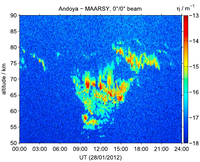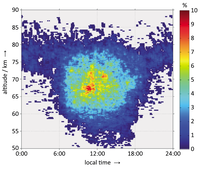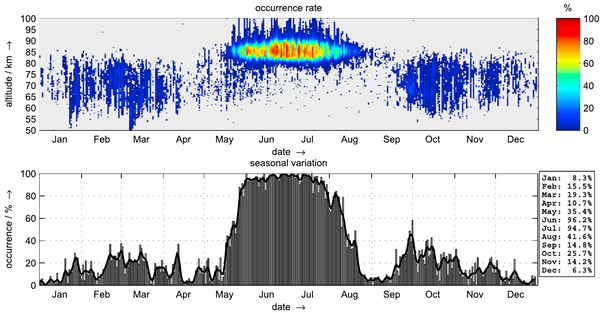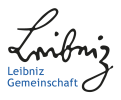- Forschungsthemen
- Abteilung Optische Sondierungen und Höhenforschungsraketen
- Abteilung Radarsondierungen
- Abteilung Modellierung atmosphärischer Prozesse
- Arbeitsgruppe Satellitendatenanalyse
- Abteilungsübergreifende Zusammenarbeit
- Projekte
- Veröffentlichungen
PMWE: Polar Mesosphere Winter Echoes
The PMWE research project initiated by the Leibniz Institute of Atmospheric Physics (IAP) in partnership with the Institute of Space Systems (IRS) and Ludwig-Maximilians-University in Munich (LMU) involving collaboration between several international and national partners will launch a total of four instrumented sounding rockets from the Andøya Space Center distributed over two campaigns in 2017 and 2018. The scientific background is as follows: Polar mesosphere winter echoes (PMWE) are relatively strong coherent radar returns from ∼55–85 km altitudes, which primarily occur during the winter season at high northern and southern latitudes. Fig. 1 demonstrates a typical PMWE display as observed by MAARSY.


PMWE are also observed, although very much more rarely, at mid-latitudes. Because of their extremely low occurrence rate, they are still poorly investigated. As a consequence, the origin of these echoes is still under debate. Currently most acceptable explanations of PMWE formation mechanism suggest that the key role plays neutral air turbulence. However, there are some features, which need additional players to explain this phenomenon. The most important among them is the background electron density which is needed to make PMWE visible for the radars. That is why PMWE more often occur during day time when solar radiation ionizes the Earth’s atmosphere (see Fig. 2). During the sounding rocket campaigns the electron density will be continuously monitored by the SAURA-MF radar. Another important player in the formation of PMWE is suggested to be the dust particles or the so-called Meteor Smoke Particles (MSP). Their importance was suggested by interpretation of the PMWE observations with the European Incoherent Scatter radars (EISCAT). Compared to PMSE (mesospheric summer echoes) PMWE occur at lower heights, are much weaker, and rare (see Fig. 3).

The turbulence inside PMWE was measured by radars which can only measure it inside the PMWE layers and only if the echo is very strong. Turbulence also was measured by using met-rockets soundings, but rather coarse and indirectly. The MSP were never reliably or directly measured in connection with PMWE. The PMWE sounding rocket mission aims at measuring all these key parameters simultaneously both in-situ and by ground based instrumentation. Thereby the main goal of the project is to gain experimental basis for theoretical explanation of the PMWE-phenomenon. In the frame of the PMWE project coordinated measurements with sounding rockets and ground based instruments will be performed. The PMWE mission has the following specific objectives:
- Precise in-situ measurements of turbulence dissipation rates in connection with PMWE.
- First time in-situ measurements of MSP inside PMWE layers.
- Estimation of the role of different parameters on formation of PMWE based on in-situ and remote measurements.
- First time simultaneous in-situ measurements of many parameters of dusty plasma in the Dregion ionosphere, including densities of electrons, MSP, positive and negative ions, and neutral gas density, temperature, and turbulence.
- First direct estimate of the contribution of atomic oxygen for ion chemistry in the MLT.
- Justify use of PMWE as a tracer for neutral dynamics.
Participants
The German sounding rocket project PMWE is lead by the
- Leibniz Institute of Atmospheric Physics (IAP), Kühlungsborn,
in partnership with the
- Institute of Space Systems (IRS) in Stuttgart and the
- Munich Meteorological Institute, Ludwig-Maximilian University of Munich (LMU),
and contributions from
- DLR-Institut für Physik der Atmosphäre (IPA), Oberpfaffenhofen, Germany
- Graz University of Technology (TUG), Austria,
- Department of Meteorology at Stockholm University (MISU) Sweden.
Rocket Experiments/Instruments
- CONE (IAP)
- MSPD (IAP)
- ECOMA (LMU/IPA/IAP)
- ROMARA (LMU/IPA)
- Faraday antennas (TUG)
- PIP (IAP)
- FIPEX (IRS)
- Farraday cup (IAP)
- MATS (MISU)
- PaT (MISU)
- TURB3D (IAP)
Funding

Staff
-
Dr. Boris Strelnikov
+49 (0) 38293 68 109 -
Prof. Dr. Franz-Josef Lübken
+49 (0) 38293 68 111 -
Dr. Tristan Staszak
+49 (0) 38293 68 144 -
Torsten Köpnick
+49 (0) 38293 68 128 -
Hans-Jürgen Heckl
+49 (0) 38293 68 322 -
Dr. Irina Strelnikova
+49 (0) 38293 68 108












